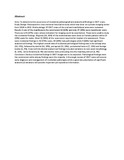| dc.description.abstract | Aims: To determine the occurrence of incidental pathological and anatomical findings in CBCT scans. Study Design: Retrospective cross sectional descriptive study which was done at a private imaging center from 2010 to 2012. Methodology: 97 CBCT scans of the oral and maxillofacial area were reviewed. Results: Scans of the maxilla were the commonest 60 (62%) and only 37 (38%) were mandibular scans. There were 55 (57%) scans whose indication for imaging could be ascertained. These were used to study the incidental findings. Majority (36, 65%) of the examinations were done on female patients while 19 (35%) were for males. Most 32 (58%) of the scans were required for implant site assessment. There were incidental findings in 40 (73%) scans, 35 (64%) had pathologies while 9 (16%) had significant anatomical findings. The highest overall rate of incidental pathological finding was in the airway area (18, 33%), followed by dental (16, 29%), periapical (13, 24%), periodontal lesions (7, 13%) and foreign bodies (2, 4%). Scans with incidental anatomical findings included variations in root canal morphology (6, 11%), nerve foramina (2, 4%) and dental roots protruding into the maxillary antrum (2, 4%). Conclusion: Various incidental findings in CBCT images are to be expected. Pathological findings were the commonest while airway findings were the majority. A thorough review of CBCT scans will ensure early diagnosis and management of incidental pathologies while a good documentation of significant anatomical variations will provide important pre-operative information. | en_US |

